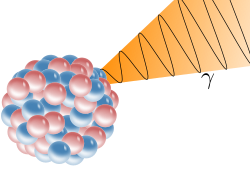Alpha particles consist of two protons and two neutrons bound together into a particle identical to a helium-4 nucleus. They are generally produced in the process of alpha decay, but may also be produced in other ways. Alpha particles are named after the first letter in the Greek alphabet, α. The symbol for the alpha particle is α or α2+. α粒子是带正电的高能粒子, 由两个质子和两个中子组成, 与He-4原子核相同, 通常由一些重原子(例如铀, 镭, 或一些人造核素)衰变时产生. 这种粒子由希腊文的第一个字符α命名, 可以写成α 或 α2+. 穿透性较差, 能被一张薄纸阻挡, 在穿过介质后迅速失去能量, 但是在穿入组织(即使是不能深入)也能引起组织的损伤. α粒子通常被人体外层坏死肌肤完全吸收, α粒子释放出的放射性同位素在人体外部不构成危险, 然而一旦被吸入或注入, 将会十分危险.
Alpha particles are commonly emitted by all of the larger radioactive nuclei such as uranium, thorium, actinium, and radium, as well as the transuranic elements. Unlike other types of decay, alpha decay as a process must have a minimum-size atomic nucleus that can support it. The smallest nuclei that have to date been found to be capable of alpha emission are the lightest nuclides of tellurium (element 52), with mass numbers between 106 and 110 (with the exception of beryllium-8). The process of alpha decay sometimes leaves the nucleus in an excited state, wherein the emission of a gamma ray then removes the excess energy. α粒子一般由较大的反射性原子核产生, 如铀, 锕和镭, 以及其他超铀元素. 不像其他衰变, α衰变需要有足够大小的原子核支持才能发生, 目前发现的支持这种衰变的最小的原子核是碲的最小同位素(元素52), 质量数介于106和110(铍-8元素除外). α衰变有时会让原子核处于活跃状态, 这时会通过γ射线将多余能量辐射出去.

A beta particle, sometimes called beta ray, denoted by the lower-case Greek letter beta (β), is a high-energy, high-speed electron or positron emitted in the radioactive decay of an atomic nucleus, such as a potassium-40 nucleus, in the process of beta decay. Two forms of beta decay, β− and β+, respectively produce electrons and positrons. Beta particles are a type of ionizing radiation. β粒子(β射线)是一种高能量高速的电子(或正电子), 由原子核在β衰变中产生, β衰变有两种形式, β− and β+, 分别对应电子和正电子. β粒子是一种电离辐射. β衰变过程当中, 放射性原子核通过发射电子和中微子转变为另一种核, 产物中的电子就被称为β粒子. 在β+衰变中, 原子核内一个质子转变为一个中子, 同时释放一个正电子; 在β-衰变中, 原子核内一个中子转变为一个质子, 同时释放一个电子, 即β粒子.
β粒子体积比α粒子小得多, 质量仅为α粒子的1/8000, 穿透能力比α粒子强, 需要一块几毫米厚的铝片才可以阻挡.

Gamma rays (also called gamma radiation), denoted by the lower-case Greek letter gamma γ, are penetrating electromagnetic radiation of a kind arising from the radioactive decay of atomic nuclei. It consists of photons in the highest observed range of photon energy. The decay of an atomic nucleus from a high energy state to a lower energy state, a process called gamma decay, produces gamma radiation. Gamma rays ionize atoms (they are ionizing radiation), and are thus biologically hazardous.
γ射线(γ辐射) 是原子核能级跃迁退激时释放出的射线, 放射性原子核在发生α衰变、β衰变后产生的新核往往处于高能量级,要向低能级跃迁,辐射出γ光子. 这是频率高于1.5 千亿亿 赫兹的电磁波光子, 波长短于0.01奈米, 波长比X射线还要短, 所以具有比X射线还要强的穿透能力. 携带高能量, 容易造成生物体细胞内的脱氧核糖核酸(DNA)断裂进而引起细胞突变.
γ射线不具有电荷及静质量,故具有较α粒子及β粒子弱之电离能力. γ射线通过物质并与原子相互作用时会产生光电效应, 康普顿效应和正负电子对效应. γ射线可被高原子数之原子核阻停, 例如铅或乏铀, 即使使用较厚材料阻挡一般也仍然有部分射线泄漏, 所以通常只能用半吸收厚度来定量材料的阻隔效果. 半吸收厚度是指入射射线强度减弱到一半时阻隔物体的厚度. 材料的射线吸收系数与射线频率, 能量以及材料种类有关, 一般原子序数高和密度高的元素构成的材料其γ射线吸收系数也较高. 普通放射源如Cs-137放射源产生的γ射线在铝、铁、铜、铅中的半吸收厚度分别约为3.2cm, 2.6cm, 1.4cm和0.6cm.
Natural sources of gamma rays on Earth are observed in the gamma decay of radionuclides and secondary radiation from atmospheric interactions with cosmic ray particles. There are rare terrestrial natural sources, such as lightning strikes and terrestrial gamma-ray flashes, that produce gamma rays not of a nuclear origin. 太空中产生的伽玛射线是由恒星核心的核聚变产生的,因为无法穿透地球大气层,因此无法到达地球的低层大气层,只能在太空中被探测到.

开孔电离室一般工作于大气压力, 但是需要防止湿度的影响. 电离室由圆柱形, 厚度为毫米级的铝或塑料制成, 材料的选择一般要接近于空气的原子数, 这样才能在接收放射能量时与空气接近. 减少室壁的影响. 壁材料越厚, 影响就越大. 电离室的一端一般会使用一个较薄的材料, 例如聚酯薄膜, 这样beta粒子才能进入室内气体, 而gamma射线能通过这端以及室壁进入. 对于手持设备, 壁厚一般是统一的这样减少beta入射窗口电子的方向性的影响. 开孔电离室一般容易受气压影响, 对于精确的测量需要有补偿和校正措施.
电子被吸附形成负离子会使脉冲的快成分受损失。所以电离室要注意气体纯度,减少负电性气体杂质
加在电极间工作电压的变化, 会影响输出中形成的电离电流强度, 其伏安特性曲线如下

I 复合区: Here Vdc is relatively low so that recombination of positive ions and electrons occurs. As a result not all ion pairs are collected and the voltage pulse height is relatively low. It does increase as the dc voltage increases however as the amount of recombination reduces. 电离电流随工作电压的增加急剧上升, 反映出电离过程中, 电离的复合损失随着电压升高急剧减小.
Ⅱ 饱和区: Vdc is sufficiently high in this region so that only a negligible amount of recombination occurs. This is the region where a type of detector called the Ionization Chamber operates.电离电流不随两极电压的升高而改变, 电离电流趋向饱和, 它反映正负离子和电子已被全部收集
Ⅲ 正比区: Vdc is sufficiently high in this region so that electrons approaching the centre wire attain sufficient energy between collisions with the electrons of gas atoms to produce new ion pairs. Thus the number of electrons is increased so that the electric charge passing through the resistor, R, may be up to a thousand times greater than the charge produced initially by the radiation interaction. This is the region where a type of detector called the Proportional Counter operates. 随着电压的增加, 初电离产生的电子在电场中得到能量后使气体进一步电离, 电离电流随电压的增加而又增加, (离子对)数目可增加到(初电离离子对)数量的1000倍, 这时工作气体本身已具有放大作用. 在这一工作区, 电离电流不仅正比于工作电压, 而且正比于(初电离离子对)数, 亦即正比于射线在探测器中消耗的能量.
Ⅳ 有限正比区: 由于电压过高, 空间离子密度很大, 在空间电荷效应的影响下, 使气体放大倍数不仅和工作电压有关, 而且和初电离大小有关. 初电离增大, 气体放大倍数减小. 不同能量粒子产生的两条伏安特性曲线β1, β2, 在该区中随着工作电压的增加, 电离电流最后趋于相等.
Ⅴ 盖革区: Vdc is so high that even a minimally-ionizing particle will produce a very large voltage pulse. The initial ionization produced by the radiation triggers a complete gas breakdown as an avalanche of electrons heads towards and spreads along the centre wire. This region is called the Geiger-Müller Region, and is exploited in the Geiger Counter. 在这一区间, 气体放大倍数急剧增大, 形成自激放电. 此时不管初电离的大小和位置如何, 电离电流的变化不大, 工作于该区的探测器称盖革一缪勒计数器.
VI 连续放电区: Here Vdc is high enough for the gas to completely breakdown and it cannot be used to detect radiation.